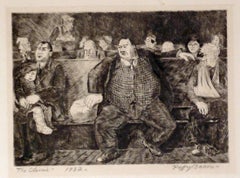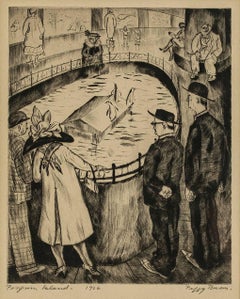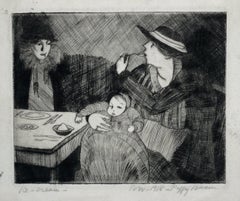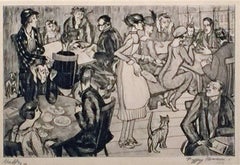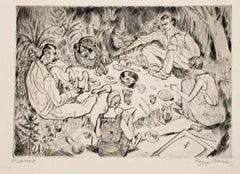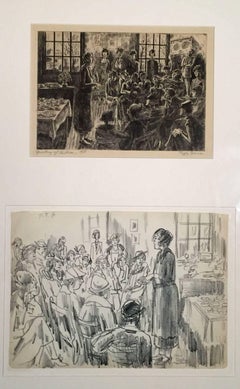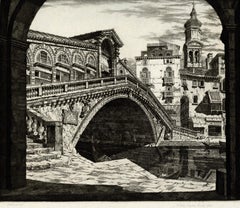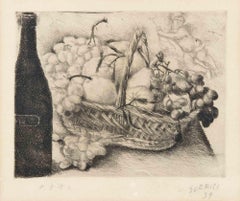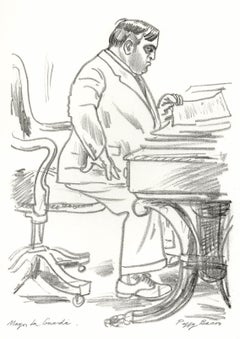Peggy Bacon Figurative Prints
to
7
5
1
2
4
Overall Height
to
Overall Width
to
3
6
5
3
3
2
2
1
1
1
7
2
3
2
9
579
410
348
305
5
5
3
Artist: Peggy Bacon
THE CLINIC
By Peggy Bacon
Located in Portland, ME
Bacon, Peggy. THE CLINIC. Flint 109. Drypoint, 1932. Edition size not known, but likely very small as the print is rare. 4 15/16 x 6 7/8 inches, plus wide margins (the sheet is 11 x ...
Category
1930s American Modern Peggy Bacon Figurative Prints
Materials
Drypoint
Drypoint Etching "Penguin Island" 1926
By Peggy Bacon
Located in Surfside, FL
Margaret Frances "Peggy" Bacon (May 2, 1895 – January 4, 1987) was an American printmaker, illustrator, painter and writer. Bacon was known for her humorous and ironic etchings and drawings, as well as for her satirical caricatures of prominent personalities in the late 1920s and 1930s. Bacon's parents were both artists and met while attending the Art Students League in New York. At the end of 1913, Bacon first studied art at the School of Applied Design for Women but disliked it calling it, "the prissiest, silliest place that ever was." She transferred after a few weeks to the School of Fine and Applied Arts on the West Wide where she took classes in illustration and life drawing. During the summer of 1914 Bacon attended Jonas Lie's landscape class in Port Jefferson, Long Island.
From 1915-1920 Bacon studied painting with Kenneth Hayes Miller, John Sloan, George Bellows and others at the Art Students League. While at the League, Bacon became friends with several other artists. Her circle of friends and acquaintances included Dorothea Schwarz (Greenbaum), Anne Rector (Duffy), Betty Burroughs (Woodhouse), Katherine Schmidt (Kuniyoshi Shubert), Yasuo Kuniyoshi, Molly Luce...
Category
1920s Modern Peggy Bacon Figurative Prints
Materials
Drypoint, Etching
ICE CREAM
By Peggy Bacon
Located in Portland, ME
Bacon, Peggy (American, 1895-1987).
ICE CREAM. Flint 6.
Drypoint, 1918.
Edition size not known, but likely very small.
Titled "Ice Cream," dated "Nov. 19...
Category
1910s Peggy Bacon Figurative Prints
Materials
Drypoint
HATTY
By Peggy Bacon
Located in Portland, ME
Bacon, Peggy.
HATTY. Flint 48. Drypoint, 1921.
Titled, signed and dated in pencil.
5 1/2 x 8 7/16 inches (plate), 9 5/16 x 12 1/2 inches (sheet).
In excellent condition.
"A rest...
Category
1920s Peggy Bacon Figurative Prints
Materials
Etching
PICNIC
By Peggy Bacon
Located in Portland, ME
Bacon, Peggy. PICNIC.
Drypoint, 1926.
Titled and signed in pencil.
5 7/8 x 8 3/8 inches.
Printed on laid paper with deckle on four sides. Very faint matstain, else in excellent c...
Category
1920s Peggy Bacon Figurative Prints
Materials
Drypoint
SPEAKING OF CHILDREN and PTA FRIEND'S SEMINARY
By Peggy Bacon
Located in Portland, ME
Bacon, Peggy. SPEAKING OF CHILDREN and PTA FRIEND'S SEMINARY. Flint 120. Etching, 1933, together with a preparatory drawing, titled "PTA Friend's Seminary." The etching titled, dated an signed in pencil. The edition size is not known, but likely small as the print is uncommon; there are no auction...
Category
1930s American Modern Peggy Bacon Figurative Prints
Materials
Etching
The Bridge Party
By Peggy Bacon
Located in New York, NY
Peggy Bacon drypoint The Bridge Party, signed, dated (Nov. 1918) and titled (Bridge) in pencil by the artist. Flint 3. In generally ok but rough condition as befits an early working ...
Category
1910s American Realist Peggy Bacon Figurative Prints
Materials
Drypoint
Related Items
Shadows of Venice
By John Taylor Arms
Located in Middletown, NY
Etching and aquatint on antique laid paper, wide margins. Signed, dated and inscribed "Edition of 100" in pencil, lower margin. Second state (of 2)....
Category
Mid-20th Century American Modern Peggy Bacon Figurative Prints
Materials
Aquatint, Laid Paper, Etching
Untitled - Drypoint by A. Soffici - 1939
By Ardengo Soffici
Located in Roma, IT
Untitled is a drypoint artist's proof realized by Ardengo Soffici (Rignano sull’Arno 1879 – Vittoria Apuana 1964).
It is signed and dated on the lower right.
This is one of the mos...
Category
1930s Modern Peggy Bacon Figurative Prints
Materials
Drypoint, Etching
Bibi Valentin
By James Abbott McNeill Whistler
Located in Storrs, CT
Bibi Valentin. 1859. Etching and drypoint. Kennedy catalog 50 state ii; Glasgow catalog 34 state ii. 6 x 8 7/8 (sheet 8 11/16 x 10 11/16). Glasgow records 44 known impressions. A rich impression with burr, printed on watermarked laid paper with full margins. Signed and dated in the plate. Housed in a 20 x 16-inch archival mat
A young girl, sits facing the viewer, leaning on her left elbow, legs extended to left. She wears a high-necked smock and buttoned boots...
Category
19th Century American Modern Peggy Bacon Figurative Prints
Materials
Etching, Drypoint
The Box at 'Faustus'
By Diana Thorne
Located in Storrs, CT
The Box at 'Faustus'. 1929. Drypoint. 11 x 8 7/8. Edition 100, #39. Signed, titled, and numbered in pencil. A rich impression printed on the full sheet of pale blue/green-toned wove paper. Signed in pencil. A tongue-in-cheek image of the devil in the opera box...
Category
1920s American Modern Peggy Bacon Figurative Prints
Materials
Etching, Drypoint
Corralled Horse (Artists Proof), 1940s Framed American Modernist Horse Etching
By Ethel Magafan
Located in Denver, CO
"Corralled Horse", is an etching on paper by western artist Ethel Magafan (1916-1993) of a single dark horse standing outside in a wooden fenced corral. Presented in a custom frame, outer dimensions measure 19 x 23 inches. Image size is 10 x 14 inches. This is marked as an Artist Proof
Piece is in very good condition - please contact us for a detailed condition report.
Provenance: Estate of Artist, Ethel Magafan
Expedited and international shipping is available - please contact us for a quote.
About the Artist:
Ethel Magafan
Born 1916
Died 1993
The daughter of a Greek immigrant father and a Polish immigrant mother who met and married in Chicago, Ethel Magafan, her identical twin sister Jenne and their elder sister Sophie grew up in Colorado to which their father relocated the family in 1919. They initially lived in Colorado Springs where he worked as a waiter at the Antlers Hotel before moving to Denver in 1930 to be head waiter at the Albany Hotel. Two years later during the Great Depression Ethel and Jenne experienced at sixteen the tragic loss of their father who had encouraged their artistic aspirations.
He was proud when Ethel, a student at Morey Junior High School, won top prizes in student poster contests sponsored by the Denver Chamber of Commerce and the Denver Post. At East High School in Denver she and Jenne contributed their art talents to the school’s and by their senior year were co-art editors of the Angelus, the 1933 yearbook. At East they studied art with Helen Perry, herself a student of André Lhote in Paris and the Art Institute of Chicago. Her decision to abandon an arts career to teach high school students served as an important example to Ethel and Jenne, who early on had decided to become artists. In a city-wide Denver competition for high school art students Ethel won an eighteenweek art course in 1932-33 to study at the Kirkland School of Art which artist Vance Kirkland had recently established in the Mile High City.
Perry encouraged the Magafan twins’ talent, exposing them to the work of Matisse, Picasso and Cézanne and introducing them to local artists and architects like Frank Mechau and Jacques Benedict whom she invited to speak in her high school art classes. She paid the modest tuition for Ethel and Jenne to study composition, color, mural designing and painting at Mechau’s School of Art in downtown Denver in 1933-34. In the summer of 1934 and for a time in 1936 they apprenticed with him at his studio in Redstone, Colorado.
When they returned to Denver in 1934 with no family breadwinner to support them, their mother insisted that they have real jobs so they worked as fashion artists in a Denver department store. When Jenne won the Carter Memorial Art Scholarship ($90.00) two years later, she shared it with Ethel so that both of them could enroll in the Broadmoor Art Academy (now the Colorado Springs Fine Arts Center) where they studied with Mechau. When the scholarship money ran out after two months, he hired them as his assistants. Along with Edward (Eduardo) Chavez and Polly Duncan, they helped him with his federal government mural commissions. At the Fine Arts Center Ethel also studied with Boardman Robinson and Peppino Mangravite, who hired her and Jenne in 1939 to assist him in his New York studio with two murals commissioned for the post office in Atlantic City, New Jersey. Like their Denver high school art teacher, Robinson also stressed the need to draw from nature in order to "feel" the mountains, which later become the dominant subject matter of Ethel’s mature work after World War II.
Mechau trained her and her sister in the complex process of mural painting while they studied at the Colorado Springs Fine Arts Center, teaching them the compositional techniques of the European Renaissance masters. This also involved library research for historical accuracy, small scale drawing, and Page 2 of 4 the hand-making of paints and other supplies. Ethel recalled that their teacher "was a lovely man but he was a hard worker. He drove us. There was no fooling around."
Her apprenticeship with Mechau prepared her to win four national government competitions, beginning at age twenty-two, for large murals in U.S. post offices: Threshing – Auburn, Nebraska (1938), Cotton Pickers – Wynne, Arkansas (1940), Prairie Fire – Madill, Oklahoma (1940), and The Horse Corral – South Denver, Colorado (1942). In preparation for their commissions Ethel and her sister made trips around the country to pending mural locations, driving their beat-up station wagon, dressed in jeans and cowboy boots with art supplies and dogs in tow. She and Jenne combined their talents in the mural, Mountains in Snow, for the Department of Health and Human Services Building in Washington, DC (1942). A year later Ethel executed her own mural, Andrew Jackson at the Battle of New Orleans, January 8, 1814, for the Recorder of Deeds Building, also in Washington, DC. Her first mural commission, Indian Dance, done in 1937 under the Treasury Department Art Project for the Senate Chamber in the United States Capitol, has since disappeared.
Ethel and her sister lived and worked in Colorado Springs until 1941 when their residence became determined by the wartime military postings of Jenne’s husband, Edward Chavez. They moved briefly to Los Angeles (1941-42) and then to Cheyenne, Wyoming, while he was stationed at Fort Warren, and then back to Los Angeles for two years in 1943. While in California, Ethel and Jenne executed a floral mural for the Sun Room of the Beverly Hills Hotel and also painted scenes of the ocean which they exhibited at the Raymond and Raymond Galleries in Beverly Hills. While in Los Angeles they met novelist Irving Stone, author of Lust for Life, who told them about Woodstock, as did artists Arnold Blanch and Doris Lee (both of whom previously taught at the Colorado Springs Fine Arts Center school. In summer of 1945 Ethel, her sister and brother-in-law drove their station wagon across the country to Woodstock which became their permanent home.
A year later Ethel married artist and musician, Bruce Currie, whom she met in Woodstock. In 1948 with the help of the GI Bill they purchased an old barn there that also housed their individual studios located at opposite ends of the house. The spatial arrangement mirrors the advice she gave her daughter, Jenne, also an artist: "Make sure you end up with a man who respects your work…The worst thing for an artist is to be in competition with her husband."
In 1951 Ethel won a Fulbright Scholarship to Greece where she and her husband spent 1951-52. In addition to extensively traveling, sketching and painting the local landscape, she reconnected with her late father’s family in the area of Messinia on the Peloponnese peninsula in southern Greece. At the same time, her sister Jenne accompanied Chavez on his Fulbright Scholarship to Italy where they spent a productive year painting and visiting museums. Shortly after returning home, Jenne’s career was cut tragically short when she died of a cerebral hemorrhage at age thirty-six. It deeply affected Ethel whose own work took on a somber quality for several years conveyed by a darkish palette, as seen in her tempera painting, Aftermath (circa 1952).
In the 1940s Ethel and her sister successfully made the important transition from government patronage to careers as independent artists. Ethel became distinguished for her modernist landscapes. Even though Ethel became a permanent Woodstock resident after World War II, from her childhood in Colorado she retained her love of the Rocky Mountains, her "earliest source of my lifelong passion for mountain landscape." She and her husband began returning to Colorado for annual summer camping trips on which they later were joined by their daughter, Jenne.
Ethel did many sketches and drawings of places she found which had special meaning for her. They enabled her to recall their vital qualities which she later painted in her Woodstock studio, conveying her feeling about places remembered. She also produced a number of watercolors and prints of the Colorado landscape that constituted a departure from the American Scene style of her earlier paintings. Her postwar creative output collectively belongs to the category of landscape abstractionists as described by author Sheldon Cheney, although to a greater or lesser degree her work references Colorado’s mountainous terrain. She introduced a palette of stronger pastels in her paintings such as two temperas, Evening Mountains from the 1950s and Springtime in the Mountains from the early 1960s.
In 1968 she was elected an Academician by the National Academy of Design in New York. Two years later, based on results of her many summer trips to Colorado, the U.S. Department of the Interior invited her to make on-the-spot sketches of the western United States, helping to document the water resources development and conservation efforts by the Department of the Interior. Her sketches were exhibited at the National Gallery in Washington, DC, and then sent on a national tour by the Smithsonian Institution. Similarly, her previous work as a muralist earned her a final commission at age sixty-three for a 12 by 20 foot Civil War image, Grant in the Wilderness, installed in 1979 in the Chancellorsville Visitors Center at the Fredericksburg National Military Park in Virginia. In the 1970s, too, she taught as Artist-in-Residence at Syracuse University and at the University of Georgia in Athens.
Her many awards include, among others, the Stacey Scholarship (1947); Tiffany Fellowship (1949); Fulbright Grant (1951-52, in Greece with her husband); Tiffany Fellowship (1949); Benjamin Altman Landscape Prize, National Academy of Design (1955); Medal of Honor, Audubon, Artists (1962); Henry Ward Granger Fund Purchase Award, National Academy of Design (1964); Childe Hassam Fund Purchase Award, American Academy of Arts and Letters (1970); Silver Medal, Audubon Artists (1983); Champion International Corporation Award, Silvermine Guild, New Canaan, Connecticut (1984); John Taylor Award, Woodstock Artists Association, Woodstock, New York (1985); Harrison Cady...
Category
1940s American Modern Peggy Bacon Figurative Prints
Materials
Etching, Paper
Dante & Virgilus - Etching, (Ed. Goupil, 1897)
By Auguste Rodin
Located in Paris, FR
ARTISTE: after Auguste RODIN
TITLE : Dante & Virgilus
MEDIUM : Etching/photogravure after the original drawing
SIGNATURE : Unsigned
YEAR : 1897
PAPER : Vellum
SIZE : 13 x 10"
INFOR...
Category
1890s Academic Peggy Bacon Figurative Prints
Materials
Etching
House on Cliff Walk, Newport, Rhode Island
By Clifford Isaac Addams
Located in Storrs, CT
House on Cliff Walk, Newport, R.I. 1931-1932. Etching and drypoint. Hausberg catalog 13 state .i/ii. Edition 75 in this state. 5 7/8 x 7 7/8 (sheet 9 x 13 1/2). A rich impression pr...
Category
Mid-20th Century American Modern Peggy Bacon Figurative Prints
Materials
Drypoint, Etching
The Spire -- New York
By Lawrence Wilbur
Located in Storrs, CT
The Spire -- New York. 1985. Etching and drypoint. 14 1/2 x 11 (sheet 22 1/2 x 18). Trial proof of the second third, prior to the edition of 100. Printed on Rives cream wove paper, on the full sheet with deckle edges. A rich impression in pristine condition, housed in an archival sleeve. This etching has never been matted. Provenance: the artist's estate. Titled, annotated 'third state - trial proof' and signed in pencil. A dramatic view of the Chrysler Building.
Painter and printmaker Lawrence Nelson...
Category
20th Century American Modern Peggy Bacon Figurative Prints
Materials
Drypoint, Etching
Janine
By Arthur William Heintzelman
Located in Storrs, CT
9 5/16 x 8 1/4 (sheet 15 1/4 x 12 3/4). Toning in the image; otherwise good condition. A rich impression with plate tone printed on cream wove paper. Signed in pencil. Housed in a 20...
Category
Mid-20th Century American Modern Peggy Bacon Figurative Prints
Materials
Drypoint, Etching
Comanche Dance, Ildefonso Pueblo, New Mexico Southwest Framed Etching
By Gene Kloss
Located in Denver, CO
Comanche Dance at San Ildefonso Pueblo (New Mexico). Etching and drypoint, artist's proof from an edition of 50 prints. Presented in a custom frame, outer dimensions measure 22 ¼ x 18 ½ x ½ inches. Image size is 11 ¾ x 14 ½ inches.
Print is clean and in very good vintage condition - please contact us for a detailed condition report.
Expedited and international shipping is available - please contact us for a quote.
About the Artist:
Gene (Alice Geneva) Kloss is considered one of America’s master printmakers. She was born in Oakland, California and established herself as an artist on the West coast.
Kloss was introduced to etching by Perham Nahl while at UC Berkley. She graduated in 1924, and in 1925 married poet Phillips Kloss. In her late twenties, Kloss moved to Taos, New Mexico and began her life’s work of the New Mexican landscape and peoples. It was at this time that she received national acclaim.
Her artwork exudes an unmistakable content and style. Enchanted by the architecture, mountainous landscapes and rituals of the inhabitants, Kloss captured the beauty of the Southwest and surrounding areas. Her style was bold yet deftly simple, masterfully expressing the elusive Southwestern light...
Category
1980s American Modern Peggy Bacon Figurative Prints
Materials
Etching, Drypoint
H 22.25 in W 18.5 in D 0.5 in
Low Country (South Carolina)
By Elizabeth Verner
Located in Middletown, NY
An enchanting Southern landscape by the mother of the Charleston Renaissance.
A native of Charleston, South Carolina, and educated under the tutelage of Thomas Anshutz at The Pennsylvania Academy of Fine Arts, O'Neill Verner was a teacher, a mother, an artist, an ardent preservationist, and a skilled autodidact. Having previously focused on painting, in the early 1920s she found herself deeply moved by printmaking as a media, and especially so by the simple, peaceful themes and tableaus she discovered in Japanese art. She embarked on a effort to teach herself Japanese printmaking techniques, and in the process, produced the charming images of every day life in Charleston and its environs that earned her recognition as a cultural icon in her day, and in more modern times, as the mother of the Charleston Renaissance, which flourished well into the 1930s. In 1923 she opened a studio in Charleston where she focused on documenting the local color and the architecture and landscape that distinguishes Charleston as one of the South's most beautiful cities, all the while applying the gentle and poetic thematic sensibilities of Japanese printmaking. O'Neill Verner soon found herself in high demand when municipalities and institutions throughout the country sought commissions from her to document the beauty of their grounds and historic buildings. She worked as far north as the campuses of Harvard and Princeton, and extensively across the South, including in Savannah, Georgia, where through sweeping commissions she was able to marry her love of southern preservation and art. O'Neill Verner was a lifelong learner, and continued a path of edification that led her to study etching at the Central School of Art in London, to travel extensively through Europe, and to visit Japan in 1937, where she studied sumi (brush and ink) painting. She was a founding member of the Charleston Etchers Club, and the Southern States Art League. Her works are represented in the permanent collections of leading museums across the American south, and in major national institutions including the Metropolitan Museum of Art, Boston's Museum of Fine Art, and the Smithsonian American Art Museum. O'Neil Verner...
Category
Early 20th Century American Modern Peggy Bacon Figurative Prints
Materials
Archival Paper, Drypoint, Etching
"The Caissons Go Rolling Along".
By Kerr Eby
Located in Storrs, CT
"The Caissons Go Rolling Along". 1929. Etching and sandpaper ground. Giardina 145. 17 3/8 x 9 1/2 (sheet 18 3/4 x 11 1/2). Edition 90. Slight mat line, otherwise find condition. A ri...
Category
1920s American Modern Peggy Bacon Figurative Prints
Materials
Drypoint, Etching
Previously Available Items
LaGuardia (Fiorella LaGuardia, GOP Mayor of NYC 1934-1945)
By Peggy Bacon
Located in New Orleans, LA
The subject of this 1934 lithographic portrait is Mayor Fiorella LaGuardia who was irascible, energetic and charismatic and acclaimed as one of America's great Mayors. Only 5ft 2in tall, La Guardia...
Category
1930s American Realist Peggy Bacon Figurative Prints
Materials
Lithograph
Drypoint Etching "Penguin Island" 1926
By Peggy Bacon
Located in Surfside, FL
Margaret Frances "Peggy" Bacon (May 2, 1895 – January 4, 1987) was an American printmaker, illustrator, painter and writer. Bacon was known for her humorous and ironic etchings and drawings, as well as for her satirical caricatures of prominent personalities in the late 1920s and 1930s. Bacon's parents were both artists and met while attending the Art Students League in New York. At the end of 1913, Bacon first studied art at the School of Applied Design for Women but disliked it calling it, "the prissiest, silliest place that ever was." She transferred after a few weeks to the School of Fine and Applied Arts on the West Wide where she took classes in illustration and life drawing. During the summer of 1914 Bacon attended Jonas Lie's landscape class in Port Jefferson, Long Island.
From 1915-1920 Bacon studied painting with Kenneth Hayes Miller, John Sloan, George Bellows and others at the Art Students League. While at the League, Bacon became friends with several other artists. Her circle of friends and acquaintances included Dorothea Schwarz (Greenbaum), Anne Rector (Duffy), Betty Burroughs (Woodhouse), Katherine Schmidt (Kuniyoshi Shubert), Yasuo Kuniyoshi, Molly Luce...
Category
1920s Modern Peggy Bacon Figurative Prints
Materials
Drypoint, Etching
Peggy Bacon figurative prints for sale on 1stDibs.
Find a wide variety of authentic Peggy Bacon figurative prints available for sale on 1stDibs. You can also browse by medium to find art by Peggy Bacon in drypoint, engraving, etching and more. Much of the original work by this artist or collective was created during the 20th century and is mostly associated with the modern style. Not every interior allows for large Peggy Bacon figurative prints, so small editions measuring 12 inches across are available. Customers who are interested in this artist might also find the work of Isabel Bishop, Kerr Eby, and John French Sloan. Peggy Bacon figurative prints prices can differ depending upon medium, time period and other attributes. On 1stDibs, the price for these items starts at $2,000 and tops out at $3,750, while the average work can sell for $2,400.
